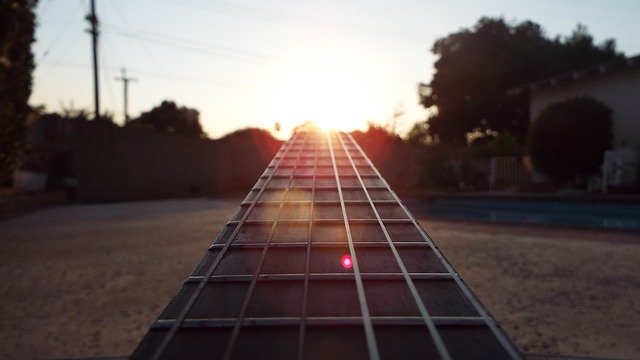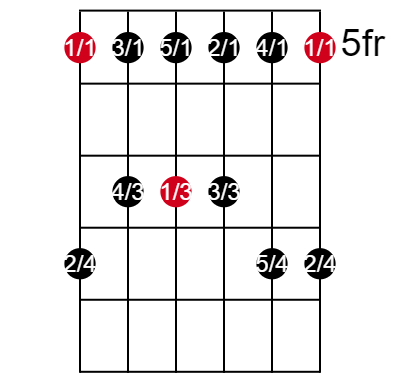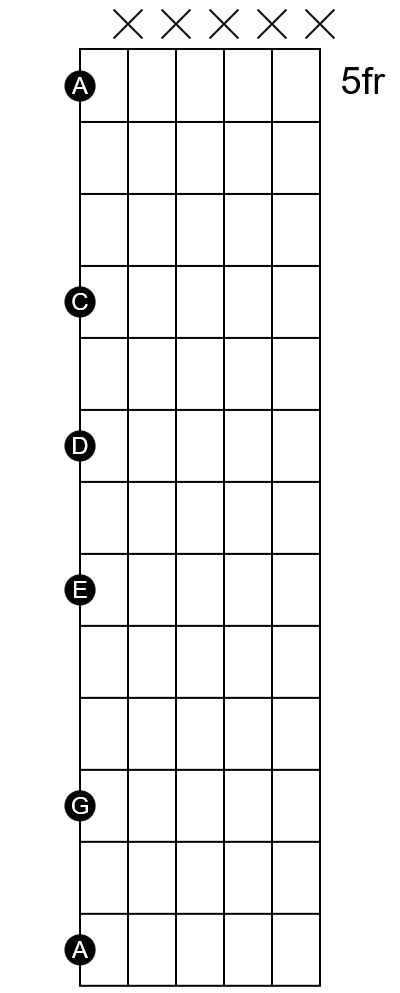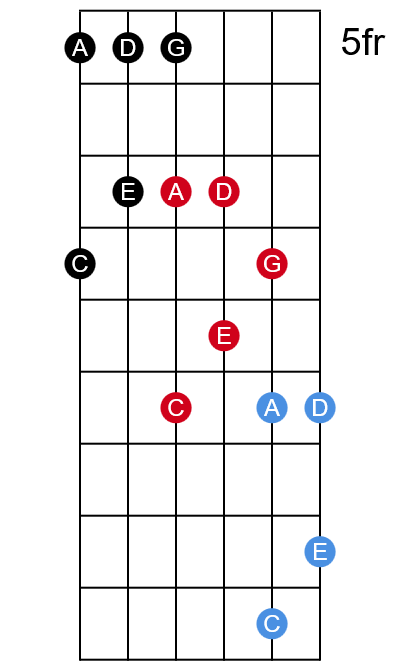
We talk about the minor pentatonic scale a lot on this site. If you’ve read any of the articles here then you know that there are five minor pentatonic boxes. You may also have been struggling to learn all of these boxes. But there’s an easy way to look at the minor pentatonic scale shapes that might help you understand the boxes more quickly and more completely. Let’s explore it.
If you don’t have a good understanding of the pentatonic scales, read
Minor pentatonic scale shapes: Box 1
Box 1 of the minor pentatonic scale might be the most commonly known shape of all. It’s often the first shape new guitarists learn for the minor pentatonic. It’s easy to remember and easy to play. The figure shows Box 1 of the A minor pentatonic scale.

Although this box is so common and pretty easy to learn and play, many guitarists never really come to understand it. It’s easy to equate the box–in fact, any of the box shapes–with the minor pentatonic scale shapes. But in actuality, each of the boxes is more than the pentatonic scale shape. Each spans two octaves (plus a note or two more) of the pentatonic scale.
After all, there are only five notes in the pentatonic scale. The box contains 12 played frets—two on each string. So clearly there are more notes than just one octave of the pentatonic scale.
For instance, look at the figure for Box 1 of the minor pentatonic scale again. Notice that the box contains three root notes. From the lowest of these root notes to the next root note is one octave of the minor pentatonic scale.
From that second root note to the third root note (the highest of the three) is another octave. So, from the lowest root note to the highest root note in the box are two full octaves.
The structure of the pentatonic scale shapes on guitar

What the diagram of Box 1 of the pentatonic scale doesn’t do a good job of showing is the structure of the pentatonic scale. This is because that structure appears to be different for the higher octave of the scale than it is for the lower octave.
But appearances are deceiving. The structures of the two octaves are identical. They just don’t appear to be identical due to how the notes fall on the guitar.
However, we have an easy way to see the structure of the minor pentatonic scale on guitar. Instead of playing the scale across strings, let’s see what it looks like stretched up one string.
No matter what string you play the scale on, when you start with the root note, it has this exact structure.
Look at the figure and notice the pattern. From the starting root note, jump three frets to the second note of the scale. Then two frets to the next note. Two more frets to the fourth note. Another three-fret jump to the fifth note. And finally, a two-fret jump back to the root note of the next octave.
And again, it looks like this no matter what string you play it on.
Moving the pentatonic scale shapes across strings again
Of course, while you can play the pentatonic scale up the neck on one string as in the figure above, that’s not a very practical shape for improvising solos.
So, let’s move the shape back to Box 1. But let’s concentrate on just one octave of the scale. This involves the first three strings.
On the low E string, the first two notes of the scale remain the same since they’re both on that string.
But instead of moving up two more frets on the E string to play the D, we play the same note by moving up to the A string and playing at the same fret (fret 5) that we started with on the E string.
Next we make a two-fret jump to play the E note on the A string at fret 7.
Now, instead of making the three-fret jump from the E to the G, we move to fret 5 of the D string, where we find the G note. Finally, another two-fret jump brings us to A, the root note of the next octave.
To sum the pattern up:
- Start at the root note
- Jump three frets to the second note of the scale
- Move up one string and back to the starting fret for the third scale note
- Skip two frets up to the fourth note of the scale
- Move up one string and back to the starting fret for the fifth scale note
- Skip two frets up to the root note of the next octave
This pattern remains the same no matter what string you start on. Well…almost the same.
That pesky B string exception
If the octave you’re playing involves the B string, then you have to modify your fingering a bit to accommodate for the B string’s different tuning interval. So on the B string, you have to move your fingers up one fret for both notes.
But while the fingering changes–that is, the fret numbers change when you encounter the B string–the pattern of frets does not change.
If you don’t understand why the B string is an exception, read
The fundamental pattern for minor pentatonic scale shapes on guitar
The pattern always starts at the root note. On the same string, jump three frets to the second note.
On the next string play the first note and jump two frets to the next note.
Finally, on the third string, start on the first note and jump two frets to the next note. That is always the pattern. Always.
When you tear the minor pentatonic scale shapes down to their core elements, you always find this pattern. No matter which of the five boxes you use, they all contain this pattern.
Use this pattern to play pentatonic scale shapes up the neck
Knowing this pattern unlocks a “secret” passage to flying up the neck.
For instance, play one octave of the A minor pentatonic scale starting at fret 5 of the Low E string (the black notes in the figure). But this time, instead of using your ring finger to play the A note at fret 7 of the D string (to start the next octave), slide your pointer from fret 5 to fret 7.

Now, repeat the pattern (the red notes in the figure). With your pointer at fret 7 of the D string, use your pinky to play fret 10—a three-fret jump.
Move up to the next string to play fret 7 of the G string with your pointer for the third note of the scale. Play the fourth note of the scale with your ring finger at fret 9.
Jump to the B string. Because it’s the B string you’ll need to move up one fret for both notes. So, play the fifth note of the scale with your pointer at fret 8. Jump two frets to fret 10 which is the A note that starts the next octave.
But again, instead of reaching for that A note with your ring finger, slide your pointer up to that note.
Now play the pattern again (the blue notes). Stretch your pinky to fret 13 for the C note. Move to the High E string at fret 10 for the D note and then the E note at fret 12 with your ring finger.
You’ve run out of strings. But with one pattern you’ve quickly moved from fret 5 up to fret 12. And you’ve played nothing but the five notes of the minor pentatonic scale.
Moving through the boxes
If you look closely, you can see what’s happened here. You’ve used the same exact pattern for all three octaves. But each time you slid your pointer finger up to play the next root note instead of using your ring finger, you actually slid from one box of the pentatonic scale to the next.
When you slid your pointer from fret 5 of the D string to fret 7, you slid out of the lower part of Box 1 of the pentatonic scale into the mid section of Box 2. Then you just repeated the same basic pattern.
When you slid your pointer from the G note at fret 8 of the B string to the root of the next octave at fret 10, you slide out of Box 2 and into the high end of Box 3. And then you just repeated that same basic pattern.
Pretty cool, right?
If you were ever wondering how you can transition from one box to another, well, now you have a super easy way to do that.
The only pattern you really need for minor pentatonic scale shapes
So, technically speaking, this one pattern is the only pattern you need to know in order to play the minor pentatonic scale anywhere on the neck. No matter where you find the root note, apply this pattern and you will play the minor pentatonic scale for an octave.
Try it. Start at fret 12 of the A string. Apply the pattern. You’ve played an octave of the A minor pentatonic scale. In that case, you’re in Box 4. But honestly, you don’t even need to know that. All you need to know is the pattern and where your root notes sit.
Start at fret 2 of the G string and apply the pattern. You’ve just played one octave of the A minor pentatonic scale. You don’t really need to know it, but you’re in box 5 here.
It simply does not matter where you find the root note. Start with your pointer on that note and apply the pattern to play an octave of the minor pentatonic scale. It works every time. Just remember to adjust the frets when the B string is involved.
And don’t forget to practice this going backward too. That way you’ll really become familiar with the pattern and how to move through the boxes.
Yes there are two paths you can go by
Here’s another thing all of this can mean for your playing. Whenever you encounter the root note of the pentatonic box, you can proceed through the scale in two different ways.
First, you can choose to stay within the box shape and come up with various licks. Or, instead, you can decide that’s a good time to slide out of that box into the adjacent box and come up with a completely different set of licks.
These types of options are one of the things that make the guitar such a fascinating (and challenging) instrument. Even if you play the exact same notes in your lick, the lick will sound slightly different if you stay in the box than it will if you move into the next box.
Any note in the box will sound different than the exact same note in one of the other boxes (unless the boxes share the same note location) because you’ll play it on a different string. The different thickness and characteristics of the strings will give the note a different timbre–that is, sound characteristics.
It’s a very cool idea to play the same lick both ways and see how different it sounds.
Conclusion
The minor pentatonic scale shapes can be a bit intimidating when you think of them in terms of five different boxes you have to learn. But you can look at the scale along just one string to learn the basic pattern of the scale on guitar.
Once you understand that pattern, you can move back to Box 1 for just one octave across three strings. That simple pattern works no matter where you find your starting root note.
You can then apply that pattern to move from one Box to the next and then to the next.
This simple pattern is the minor pentatonic scale in its most basic form. It makes the scale less intimidating and gives you an easy way to transition from one Box shape into another.

Great stuff here, making these things click is what takes it from a rote memorization to gaining some real flow to playing! Thanks!
Thanks, BP! I’m glad you found the approach useful. It was one of those moments in my own discovery when I suddenly saw the pentatonic scale in a completely new way. I’m glad to know if helps you too!
This is super helpful. I never knew it worked that way. I memorized the shapes but nobody has ever connected the dots for me like that.
Thanks, Chance! The longer you play guitar, the more of these little light bulbs start going off. That’s one of the things I love about the instrument. You never stop learning!
This is wonderful. You can really disseminate knowledge. I am glad you have rekindled my liking for guitar. I was wondering why I had difficulties getting out of the f….king boxes. Thank you a lot
When you say, “I am glad you have rekindled my liking for guitar,” you make me very happy. This is what I hope to do with this information. Thank you for taking the time to read and to let me know the information is helpful and maybe even inspiring!
I have picked at the guitar since I was a teenager with little to no success. Now that I am in my 50’s I am really going at it through your training and what a difference it has made. I tried YouTube a lot, but nothing connected everything together quite like you do. The only thing I would suggest is some kind of menu listing all the lessons. But the lessons themselves are perfect. I loved the history on Pentatonics. Keep up the great work. Thank you from all of us to you!
Hi Tony. Thank you so much for the kind words. I’m very happy that you’ve found this material useful. Your message is quite inspiring for me. I hope to make improvements to the site in the future. But for now, it’s great to hear that you are making progress. And don’t give up! I too was in my 50s when I really started making real progress after 30 years of playing and even playing in bands. Sometimes it just takes someone to present something in a way that speaks to you. I’m glad my articles do that for you!
Am really inspired with your new way to see the Minor Pentatonic scale boxes…. I am in my mid 50s and work on large ships across the oceans. Have been playing on and off…This time I carried my little G# guitar for practice. Boring evenings are of the past now…. Guitar practice is now more purposeful. A big plus for mental well being. Thank you Gary. Godbless.
Thank you, Goan. I’m glad I can ride along with you on both your trans-ocean and guitar journeys. Good luck with your practice. Keep at it!